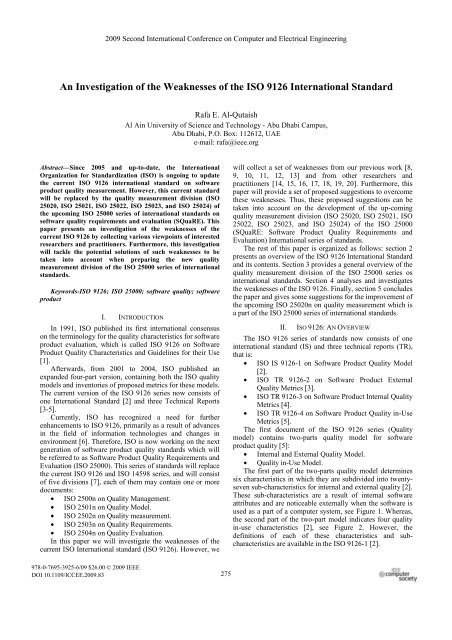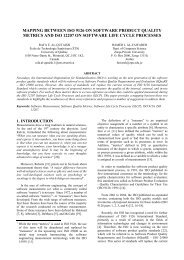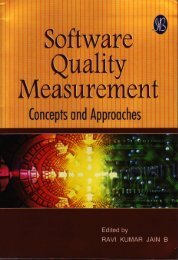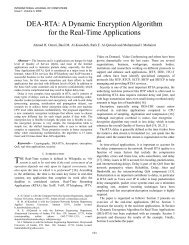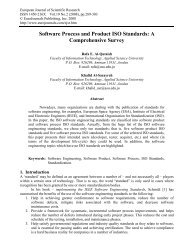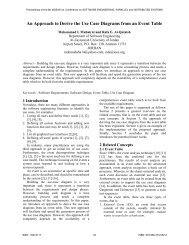An Investigation of the Weaknesses of the ISO 9126 International ...
An Investigation of the Weaknesses of the ISO 9126 International ...
An Investigation of the Weaknesses of the ISO 9126 International ...
You also want an ePaper? Increase the reach of your titles
YUMPU automatically turns print PDFs into web optimized ePapers that Google loves.
Figure 1. <strong>ISO</strong> <strong>9126</strong> quality model for external and internal quality (characteristics and sub-characteristics).<br />
Figure 2. <strong>ISO</strong> <strong>9126</strong> quality model for quality in-use (characteristics).<br />
The second [3], third [4] and fourth [5] parts <strong>of</strong> <strong>the</strong> <strong>ISO</strong><br />
<strong>9126</strong> series provide <strong>the</strong> following information:<br />
• Sets <strong>of</strong> metrics for each external quality subcharacteristic,<br />
internal quality sub-characteristic and<br />
quality in-use characteristic.<br />
• Explanations <strong>of</strong> how to apply and use <strong>the</strong>se sets <strong>of</strong><br />
metrics.<br />
• Examples <strong>of</strong> how and where to apply <strong>the</strong>se metrics<br />
during <strong>the</strong> s<strong>of</strong>tware product lifecycle.<br />
III.<br />
THE QUALITY MEASUREMENT DIVISION OF <strong>ISO</strong><br />
25000: AN OVERVIEW<br />
One <strong>of</strong> <strong>the</strong> objectives <strong>of</strong> this new <strong>ISO</strong> 25000 series (and<br />
what makes it different from <strong>the</strong> current <strong>ISO</strong> <strong>9126</strong> series) is<br />
<strong>the</strong> harmonization <strong>of</strong> its contents with <strong>the</strong> s<strong>of</strong>tware<br />
measurement terminology <strong>of</strong> <strong>ISO</strong> 15939 [10] which itself<br />
based on <strong>the</strong> <strong>ISO</strong> metrology terminology [21].<br />
Figure 3 shows <strong>the</strong> structure <strong>of</strong> <strong>the</strong> quality measurement<br />
division (<strong>ISO</strong> 2502n) series that is to replace <strong>the</strong> current<br />
four-part <strong>ISO</strong> <strong>9126</strong> series <strong>of</strong> standards [22]. This proposed<br />
quality measurement division (<strong>ISO</strong> 2502n) will consist <strong>of</strong><br />
five documents:<br />
• <strong>ISO</strong> 25020 on Measurement Reference Model and<br />
Guide.<br />
• <strong>ISO</strong> 25021 on Quality Measure Elements.<br />
• <strong>ISO</strong> 25022 on Measurement <strong>of</strong> Internal Quality.<br />
• <strong>ISO</strong> 25023 on Measurement <strong>of</strong> External Quality.<br />
• <strong>ISO</strong> 25024 on Measurement <strong>of</strong> Quality in Use.<br />
The work on <strong>ISO</strong> 25000 is being carried out by Working<br />
Group 6 (WG6) <strong>of</strong> <strong>the</strong> s<strong>of</strong>tware and system engineering<br />
subcommittee (SC7) <strong>of</strong> <strong>the</strong> <strong>ISO</strong>/IEC joint technical<br />
committee (JTC1) on Information Technology, that is,<br />
<strong>ISO</strong>/IEC JTC1/SC7 1 .<br />
1 The author is a Canadian representative and committee<br />
member <strong>of</strong> <strong>the</strong> <strong>ISO</strong>/IEC Joint Committee 1 – Subcommittee<br />
7 (JTC1/SC7) – Work Group 6 on S<strong>of</strong>tware Evaluation and<br />
Measurement.<br />
276
Figure 3. The structure <strong>of</strong> <strong>the</strong> measurement division (<strong>ISO</strong> 2502n series).<br />
IV. THE WEAKNESSES OF <strong>ISO</strong> <strong>9126</strong><br />
In this section we will discuss <strong>the</strong> weaknesses <strong>of</strong> <strong>the</strong> <strong>ISO</strong><br />
<strong>9126</strong>. However, <strong>the</strong>se weaknesses will be classified into two<br />
classes, that is, <strong>the</strong> weaknesses which we have identified<br />
during our previous work, and <strong>the</strong> weaknesses which are<br />
discovered by o<strong>the</strong>r researchers and practitioners.<br />
A. Self-Discovered <strong>Weaknesses</strong><br />
During our previous research, we have found <strong>the</strong><br />
following weaknesses <strong>of</strong> <strong>ISO</strong> <strong>9126</strong>:<br />
1) The terminology needs to be harmonized with <strong>the</strong><br />
<strong>ISO</strong> <strong>International</strong> Vocabulary <strong>of</strong> Basic and General<br />
Terms in Metrology [8].<br />
2) The metrics in <strong>ISO</strong> <strong>9126</strong> parts 2, 3, and 4 are<br />
completely merged and need to be classified into<br />
base and derived metrics to be aligned with <strong>the</strong> <strong>ISO</strong><br />
15939 [9].<br />
3) It is to be noted that <strong>the</strong> ranges <strong>of</strong> <strong>the</strong> results <strong>of</strong> many<br />
<strong>of</strong> <strong>the</strong> metrics in <strong>ISO</strong> <strong>9126</strong> are between 0 and 1.<br />
Therefore, it is easy to convert <strong>the</strong>m to percentage<br />
values. However, from our point <strong>of</strong> view, <strong>the</strong>se<br />
results would be easier to understand if <strong>the</strong>y were<br />
ranked in terms <strong>of</strong> qualitative values; for example,<br />
for task completion, if <strong>the</strong> percentage result is 100%,<br />
<strong>the</strong>n <strong>the</strong> completion <strong>of</strong> <strong>the</strong> task is labeled “excellent”;<br />
if <strong>the</strong> result is 80%, <strong>the</strong>n <strong>the</strong> completion <strong>of</strong> <strong>the</strong> task is<br />
labeled “very good”; and so on [10, 13].<br />
4) When mapping <strong>the</strong> <strong>ISO</strong> <strong>9126</strong> to <strong>ISO</strong> 12207, many <strong>of</strong><br />
<strong>the</strong> <strong>ISO</strong> <strong>9126</strong> quality metrics referred to <strong>ISO</strong> 12207<br />
processes. However, as known, each process in <strong>ISO</strong><br />
12207 contains a number <strong>of</strong> different activities.<br />
Thus, it is more usable for <strong>the</strong> <strong>ISO</strong> <strong>9126</strong> users to<br />
refer to <strong>the</strong> activities <strong>of</strong> <strong>the</strong> <strong>ISO</strong> 12207 [11, 12].<br />
B. The <strong>Weaknesses</strong> Discovered by o<strong>the</strong>r Researchers<br />
The following are <strong>the</strong> weaknesses which have been<br />
identified by o<strong>the</strong>r researchers:<br />
1) Jung et al. [14] stated that including <strong>the</strong> six<br />
compliance sub-characteristics leads to two possible<br />
results. The first possibility is that <strong>the</strong> compliance<br />
sub-characteristic for each characteristic belongs to<br />
its characteristic as defined in <strong>ISO</strong> <strong>9126</strong>. The second<br />
possibility is that <strong>the</strong> six compliance subcharacteristics<br />
constitute a separate dimension [14].<br />
Fur<strong>the</strong>rmore, <strong>the</strong>ir results reveal ambiguities in <strong>the</strong><br />
way that <strong>ISO</strong> <strong>9126</strong> is structured in terms <strong>of</strong><br />
characteristics and sub-characteristics.<br />
2) Chua and Dyson [15] - in <strong>the</strong>ir investigation -<br />
uncovered some inherent weaknesses in <strong>the</strong> <strong>ISO</strong><br />
<strong>9126</strong> quality model, particularly with regards to <strong>the</strong><br />
Usability characteristic. To make <strong>the</strong> model simpler<br />
to use for educators, who may not be usability<br />
experts, <strong>the</strong>y propose that this characteristic should<br />
be extended to include more specific factors such as<br />
consistency, simplicity, legibility and color use. It is<br />
also suggested that a Help sub-characteristic be<br />
included as part <strong>of</strong> Usability, mainly to ensure that<br />
this important factor should not be neglected. In<br />
addition, we propose <strong>the</strong> inclusion <strong>of</strong> user<br />
satisfaction as a global characteristic to summarize<br />
<strong>the</strong> general impact <strong>of</strong> <strong>the</strong> system on <strong>the</strong> user in <strong>the</strong>ir<br />
specific educational context and given <strong>the</strong>ir specific<br />
requirements. With <strong>the</strong>se improvements, <strong>ISO</strong> <strong>9126</strong><br />
could be a useful model for evaluating <strong>the</strong> quality <strong>of</strong><br />
e-learning systems [14].<br />
3) Based on <strong>the</strong> <strong>ISO</strong> <strong>9126</strong> standard, as well as an<br />
investigation <strong>of</strong> o<strong>the</strong>r models proposed by various<br />
Quality Measure Elements (<strong>ISO</strong> 25021)<br />
Measurement <strong>of</strong> External Quality (<strong>ISO</strong> 25023)<br />
Measurement <strong>of</strong> Internal Quality (<strong>ISO</strong> 25022)<br />
Measurement <strong>of</strong> Quality in Use (<strong>ISO</strong> 25024)<br />
easurement Reference Model and Guide (<strong>ISO</strong> 25020)<br />
authors, Abran et al. [16] stated that revised structure<br />
for a usability model need to be proposed, including<br />
<strong>the</strong> addition <strong>of</strong> two characteristics to <strong>the</strong> <strong>ISO</strong> <strong>9126</strong><br />
standard which had been selected as <strong>the</strong>ir baseline:<br />
learnability and security. Then, specific metrics for<br />
277
<strong>the</strong>se characteristics were presented using <strong>the</strong><br />
structured hierarchy <strong>of</strong> <strong>ISO</strong> <strong>9126</strong> [16].<br />
4) Bøegh [17] stated that he could not apply <strong>the</strong> <strong>ISO</strong><br />
<strong>9126</strong> metrics directly because <strong>the</strong>y are imprecise. In<br />
addition, <strong>the</strong> project team in his study devoted<br />
considerable effort to redefining <strong>the</strong> metrics and<br />
applying <strong>the</strong> formalized approach with counting rules<br />
and pr<strong>of</strong>iles [17]. The complex attributes based on<br />
standards required a careful examination <strong>of</strong> <strong>the</strong><br />
standards, but <strong>the</strong>y eventually turned out to be easier<br />
to define [17].<br />
5) Koscianski and Costa [18] stated that <strong>the</strong><br />
normalization <strong>of</strong> metrics and scores must accomplish<br />
<strong>the</strong> following: every metric used must be mapped to<br />
<strong>the</strong> same reference scale [18]. The sample metrics <strong>of</strong><br />
<strong>ISO</strong>/IEC <strong>9126</strong>-2 and <strong>ISO</strong>/IEC <strong>9126</strong>-3 generally<br />
return values in <strong>the</strong> range [0, 1], where 1 means <strong>the</strong><br />
best possible result. Fur<strong>the</strong>rmore, qualitative metrics<br />
may use <strong>the</strong> same concept [18].<br />
6) Behkamal et al. [19] stated that <strong>the</strong> <strong>ISO</strong> <strong>9126</strong> quality<br />
model is a general one. In addition, <strong>the</strong>y noted that in<br />
order to apply this standard, it needs to be<br />
customized [19].<br />
7) Erazo [20] has analyzed <strong>the</strong> <strong>ISO</strong> <strong>9126</strong> quality model<br />
and presented <strong>the</strong> results <strong>of</strong> an actual evaluation,<br />
illustrating each characteristic with <strong>the</strong>ir respective<br />
valued aspects.<br />
V. CONCLUSION<br />
Nowadays, <strong>ISO</strong> is ongoing to update <strong>the</strong> current <strong>ISO</strong><br />
<strong>9126</strong> international standard on s<strong>of</strong>tware product quality<br />
measurement. However, this current standard will be<br />
replaced by <strong>the</strong> upcoming quality measurement division<br />
(<strong>ISO</strong> 25020, <strong>ISO</strong> 25021, <strong>ISO</strong> 25022, <strong>ISO</strong> 25023, and <strong>ISO</strong><br />
25024) <strong>of</strong> <strong>the</strong> <strong>ISO</strong> 25000 series <strong>of</strong> international standards on<br />
s<strong>of</strong>tware quality requirements and evaluation (SQuaRE).<br />
This paper presented an investigation on <strong>the</strong> weaknesses<br />
<strong>of</strong> <strong>the</strong> current <strong>ISO</strong> <strong>9126</strong> international standard by collecting<br />
different viewpoints from our previous researches and from<br />
interested researchers and practitioners. However, this paper<br />
has tackled <strong>the</strong> following suggestion to resolve such<br />
weaknesses:<br />
• Ensure that <strong>the</strong> terminology on s<strong>of</strong>tware product<br />
quality measurement is fully aligned with <strong>the</strong> classic<br />
measurement terminology in <strong>the</strong> sciences and in<br />
engineering.<br />
• Identify and classify <strong>the</strong> <strong>ISO</strong> <strong>9126</strong> metrics into base<br />
and derived metrics to make it easy to determine<br />
which base metrics should be collected to be used<br />
subsequently in computing <strong>the</strong> o<strong>the</strong>r derived metrics.<br />
• Convert <strong>the</strong> result <strong>of</strong> <strong>the</strong> <strong>ISO</strong> <strong>9126</strong> metrics to<br />
percentage values to be more understandable.<br />
• To overcome <strong>the</strong> problem on <strong>the</strong> mapping between<br />
<strong>ISO</strong> <strong>9126</strong> and <strong>ISO</strong> 12207, a cross-reference numbers<br />
from <strong>ISO</strong> 12207 can be used. For example, <strong>the</strong><br />
cross-reference number 5.3.9 is referring to “primary<br />
processes”, ‘development process’ and ‘s<strong>of</strong>tware<br />
qualification testing’ activity, respectively, Fig. 3 for<br />
an example on where <strong>the</strong> <strong>ISO</strong> <strong>9126</strong> internal quality<br />
metrics could be measured within <strong>the</strong> <strong>ISO</strong> 12207<br />
verification activities.<br />
• Ignore <strong>the</strong> compliance sub-characteristic for each<br />
characteristic in <strong>ISO</strong> <strong>9126</strong> quality model.<br />
• Additional empirical work is necessary for clarity<br />
and validates <strong>the</strong> <strong>ISO</strong> <strong>9126</strong> quality model structure<br />
in terms <strong>of</strong> characteristics and sub-characteristics.<br />
• The usability characteristic should be extended to<br />
include more specific sub-characteristics such as<br />
consistency, simplicity, legibility, color use, and<br />
help.<br />
• Include <strong>the</strong> addition <strong>of</strong> two characteristics to <strong>the</strong> <strong>ISO</strong><br />
9241-11 standard which had been selected as <strong>the</strong>ir<br />
baseline: learnability and security. Then, specific<br />
metrics for <strong>the</strong>se characteristics need to be presented<br />
using <strong>the</strong> structured hierarchy <strong>of</strong> <strong>ISO</strong> <strong>9126</strong>.<br />
• Redefine <strong>the</strong> <strong>ISO</strong> <strong>9126</strong> metrics and apply a<br />
formalized approach with counting rules and pr<strong>of</strong>iles<br />
to <strong>the</strong> <strong>ISO</strong> <strong>9126</strong> metrics.<br />
• Map each <strong>of</strong> <strong>the</strong> <strong>ISO</strong> <strong>9126</strong> metrics to <strong>the</strong> same<br />
reference scale.<br />
• Make <strong>the</strong> <strong>ISO</strong> <strong>9126</strong> be ready for customization to be<br />
used in any domain.<br />
• The <strong>ISO</strong> <strong>9126</strong> quality model characteristics need to<br />
be ranked by <strong>the</strong>ir usability and importance.<br />
REFERENCES<br />
[1] <strong>ISO</strong>, S<strong>of</strong>tware Product Evaluation - Quality Characteristics<br />
and Guidelines for Their Use (<strong>ISO</strong>/IEC IS <strong>9126</strong>). Geneva,<br />
Switzerland: <strong>International</strong> Organization for Standardization<br />
1991.<br />
[2] <strong>ISO</strong>, S<strong>of</strong>tware Engineering - Product Quality - Part 1: Quality<br />
Model (<strong>ISO</strong>/IEC IS <strong>9126</strong>-1). Geneva, Switzerland:<br />
<strong>International</strong> Organization for Standardization, 2001.<br />
[3] <strong>ISO</strong>, S<strong>of</strong>tware Engineering - Product Quality - Part 2:<br />
External Metrics (<strong>ISO</strong>/IEC TR <strong>9126</strong>-2). Geneva, Switzerland:<br />
<strong>International</strong> Organization for Standardization, 2003.<br />
[4] <strong>ISO</strong>, S<strong>of</strong>tware Engineering - Product Quality - Part 3: Internal<br />
Metrics (<strong>ISO</strong>/IEC TR <strong>9126</strong>-3). Geneva, Switzerland:<br />
<strong>International</strong> Organization for Standardization, 2003.<br />
[5] <strong>ISO</strong>, S<strong>of</strong>tware Engineering - Product Quality - Part 4: Quality<br />
in-Use Metrics (<strong>ISO</strong>/IEC TR <strong>9126</strong>-4). Geneva, Switzerland:<br />
<strong>International</strong> Organization for Standardization, 2004.<br />
[6] M. Azuma, "SQuaRE: The Next Generation <strong>of</strong> <strong>ISO</strong>/IEC <strong>9126</strong><br />
and 14598 <strong>International</strong> Standards Series on S<strong>of</strong>tware Product<br />
Quality," Proc. <strong>of</strong> <strong>the</strong> European S<strong>of</strong>tware Control and Metrics<br />
Conference (ESCOM’01), London, UK, 2001, pp. 337-346.<br />
[7] <strong>ISO</strong>, S<strong>of</strong>tware Engineering - S<strong>of</strong>tware Product Quality<br />
Requirements and Evaluation (SQuaRE) - Guide to SQuaRE<br />
(<strong>ISO</strong>/IEC 25000), Geneva, Switzerland: <strong>International</strong><br />
Organization for Standardization, 2005.<br />
278
[8] A. Abran, R. E. Al-Qutaish, and J.-M. Desharnais,<br />
"Harmonization issues in <strong>the</strong> updating <strong>of</strong> <strong>the</strong> <strong>ISO</strong> standards on<br />
s<strong>of</strong>tware product quality," Metrics News: Journal <strong>of</strong> <strong>the</strong><br />
S<strong>of</strong>tware Metrics Community, Vol. 10, No. 2, 2005, pp. 35-<br />
44.<br />
[9] A. Abran, R. E. Al-Qutaish, J.-M. Desharnais, and N. Habra,<br />
"<strong>An</strong> information model for s<strong>of</strong>tware quality measurement<br />
with <strong>ISO</strong> standards," Proc. <strong>of</strong> <strong>the</strong> <strong>International</strong> Conference on<br />
S<strong>of</strong>tware Development (SWDC-REK'05), Reykjavik, Iceland,<br />
2005, pp. 104-116.<br />
[10] A. Abran, R. E. Al-Qutaish, and J. Cuadrado-Gallego,<br />
"<strong>An</strong>alysis <strong>of</strong> <strong>the</strong> <strong>ISO</strong> <strong>9126</strong> on S<strong>of</strong>tware Product Quality<br />
Evaluation from <strong>the</strong> Metrology and <strong>ISO</strong> 15939 Perspectives<br />
WSEAS Transactions on Computers, Vol. 5, No. 11, 2006,<br />
pp. 2778-2786.<br />
[11] R. E. Al-Qutaish, "Measuring <strong>the</strong> S<strong>of</strong>tware Product Quality<br />
during <strong>the</strong> S<strong>of</strong>tware Development Life-Cycle: <strong>An</strong><br />
<strong>International</strong> Organization for Standardization Standards<br />
Perspective," Journal <strong>of</strong> Computer Science, Vol. 5, No. 5,<br />
2009, pp. 392-397.<br />
[12] R. E. Al-Qutaish and H. Jalfawareh, "Mapping Between <strong>ISO</strong><br />
<strong>9126</strong> on S<strong>of</strong>tware Product Quality Metrics and <strong>ISO</strong> 12207 on<br />
S<strong>of</strong>tware Life Cycle Processes," Proc. <strong>of</strong> <strong>the</strong> <strong>International</strong><br />
Arab Conference on Information Technology (ACIT'06),<br />
Yarmouk University, Irbid, Jordan, 2006.<br />
[13] A. Abran, R. E. Al-Qutaish, and J. Cuadrado-Gallego,<br />
"<strong>Investigation</strong> <strong>of</strong> <strong>the</strong> Metrology Concepts in <strong>ISO</strong> <strong>9126</strong> on<br />
S<strong>of</strong>tware Product Quality Evaluation," Proc. <strong>of</strong> <strong>the</strong> 10th<br />
<strong>International</strong> Conference on Computers (ICComp'06),<br />
Vouliagmeni, A<strong>the</strong>ns, Greece, 2006, pp. 864-872.<br />
[14] H.-W. Jung, S.-G. Kim, and C.-S. Chung, "Measuring<br />
S<strong>of</strong>tware Product Quality: A Survey <strong>of</strong> <strong>ISO</strong>/IEC <strong>9126</strong>," IEEE<br />
S<strong>of</strong>tware, Vol. 21, No. 5, 2004, pp. 89-92.<br />
[15] B. B. Chua and L. E. Dyson, "Applying <strong>the</strong> <strong>ISO</strong> <strong>9126</strong> Model<br />
to <strong>the</strong> Evaluation <strong>of</strong> an e-Learning System," Proc. <strong>of</strong> <strong>the</strong> 21st<br />
Conference <strong>of</strong> <strong>the</strong> Australasian Society for Computers in<br />
Learning in Tertiary Education (ASCILITE'04), Perth,<br />
Australia, 2004, pp. 184-190.<br />
[16] A. Abran, A. Khelifi, W. Suryn, and A. Seffah,<br />
"Consolidating <strong>the</strong> <strong>ISO</strong> Usability Models," Proc. <strong>of</strong> 11th<br />
<strong>International</strong> S<strong>of</strong>tware Quality Management Conference,<br />
Glasgow, Scotland, UK, 2003.<br />
[17] J. Boegh, "Certifying S<strong>of</strong>tware Component Attributes," IEEE<br />
S<strong>of</strong>tware, Vol. 23, No. 3, 2006, pp. 74 – 81.<br />
[18] A. Koscianski and J. C. Bracarense Costa, "Combining<br />
<strong>An</strong>alytical Hierarchical <strong>An</strong>alysis with <strong>ISO</strong>/IEC <strong>9126</strong> for a<br />
Complete Quality Evaluation Framework," Proc. <strong>of</strong> <strong>the</strong> 4th<br />
IEEE <strong>International</strong> Symposium and Forum on S<strong>of</strong>tware<br />
Engineering Standards (ISESS'99), Curitiba, Brazil, 1999, pp.<br />
218-216.<br />
[19] B. Behkamala, M. Kahanib, and M. K. Akbar, "Customizing<br />
<strong>ISO</strong> <strong>9126</strong> quality model for evaluation <strong>of</strong> B2B applications,"<br />
Information and S<strong>of</strong>tware Technology, Vol. 51, No. 3, 2009,<br />
pp. 599-609.<br />
[20] S. Riascos-Erazo, "Evaluation <strong>of</strong> <strong>the</strong> Quality (norm <strong>ISO</strong><br />
<strong>9126</strong>) in Applications Educational Multimediales,"<br />
FORMATEX Magazine, 2006, Vol. 5, pp. 832-836.<br />
[21] <strong>ISO</strong>, <strong>International</strong> Vocabulary <strong>of</strong> Basic and General Terms in<br />
Metrology (VIM). Geneva, Switzerland: <strong>International</strong><br />
Organization for Standardization, 1993.<br />
[22] <strong>ISO</strong>, S<strong>of</strong>tware Engineering - S<strong>of</strong>tware Product Quality<br />
Requirements and Evaluation (SQuaRE) - Quality Measure<br />
Elements (<strong>ISO</strong>/IEC TR 25021). Geneva, Switzerland:<br />
<strong>International</strong> Organization for Standardization, 2007.<br />
279


